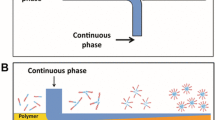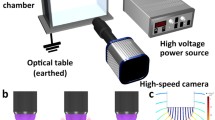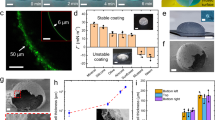Abstract
A new method for generation of nanoliter-volume, two-phase (compound) droplets with the ability to vary composition (i.e., encapsulant thickness) is presented. Thermocapillary-driven levitation of water droplets, a capability with potential for the improvement of lab-on-a-chip (LOC) processes, requires encapsulation by a secondary, less-volatile fluid that will also avoid the adverse effects of water-surface contamination on the driving surface motion. Key components of the closed system include the droplet generator actuated by a piezoelectric diaphragm, a pressure-control device, and a specialized nozzle for delivery of the encapsulating liquid. Experimental investigations demonstrate how system pressure variations allow composition changes, and voltage waveform input parameters regulate ejection dynamics, necessary for droplet capturing during the levitation process.









Similar content being viewed by others
References
Andreas JM, Hauser EA, Tucker WB (1938) Boundary tension by pendant drops. J Phys Chem US 42:1001–1019
Barton KD, Subramanian RS (1989) The migration of liquid-drops in a vertical temperature-gradient. J Colloid Interf Sci 133:211–222
Basaran OA (2002) Small-scale free surface flows with breakup: drop formation and emerging applications. AIChE J 48:1842–1848
Che ZZ, Wong TN, Nguyen NT, Chai JC (2012) Formation and breakup of compound pendant drops at the tip of a capillary and its effect on upstream velocity fluctuations. Int J Heat Mass Transf 55:1022–1029
Chen AU, Basaran OA (2002) A new method for significantly reducing drop radius without reducing nozzle radius in drop-on-demand drop production. Phys Fluids 14:L1–L4
Chen JN, Stebe KJ (1997) Surfactant-induced retardation of the thermocapillary migration of a droplet. J Fluid Mech 340:35–59
Christopher GF, Anna SL (2007) Microfluidic methods for generating continuous droplet streams. J Phys D Appl Phys 40:R319–R336
Dell’Aversana P, Neitzel GP (2004) Behavior of noncoalescing and nonwetting drops in stable and marginally stable states. Exp Fluids 36:299–308
Kline SJ, McClintock F (1953) Describing uncertainties in single-sample experiments. Mech Eng 75:3–8
Loscertales IG, Barrero A, Guerrero I, Cortijo R, Marquez M, Ganan-Calvo AM (2002) Micro/nano encapsulation via electrified coaxial liquid jets. Science 295:1695–1698
Nagy PT, Neitzel GP (2008) Optical levitation and transport of microdroplets: proof of concept. Phys Fluids 20:1–4
Okushima S, Nisisako T, Torii T, Higuchi T (2004) Controlled production of monodisperse double emulsions by two-step droplet breakup in microfluidic devices. Langmuir 20:9905–9908
Planchette C, Lorenceau E, Brenn G (2010) Liquid encapsulation by binary collisions of immiscible liquid drops. Colloid Surf A 365:89–94
Terwagne D, Gilet T, Vandewalle N, Dorbolo S (2010) Double emulsion in a compound droplet. Colloid Surf A 365:178–180
Terwagne D, Ludewig F, Vandewalle N, Dorbolo S (2013) The role of the droplet deformations in the bouncing droplet dynamics. Phys Fluids 25(12):122101
Umbanhowar PB, Prasad V, Weitz DA (2000) Monodisperse emulsion generation via drop break off in a coflowing stream. Langmuir 16:347–351
Utada AS, Lorenceau E, Link DR, Kaplan PD, Stone HA, Weitz DA (2005) Monodisperse double emulsions generated from a microcapillary device. Science 308:537–541
Wijshoff H (2010) The dynamics of the piezo inkjet printhead operation. Phys Rep 491:77–177
Yang JC, Chien W, King M, Grosshandler WL (1997) A simple piezoelectric droplet generator. Exp Fluids 23:445–447
Young NO, Goldstein JS, Block MJ (1959) The motion of bubbles in a vertical temperature gradient. J Fluid Mech 6:350–356
Acknowledgments
This work was supported by the National Science Foundation under grant CBET-0828820 and by the National Aeronautics and Space Administration under grant NNX08BB04G.
Author information
Authors and Affiliations
Corresponding author
Rights and permissions
About this article
Cite this article
Black, J., Neitzel, G.P. Nanoliter compound-droplet generation with composition variation. Microfluid Nanofluid 20, 133 (2016). https://doi.org/10.1007/s10404-016-1799-x
Received:
Accepted:
Published:
DOI: https://doi.org/10.1007/s10404-016-1799-x




